
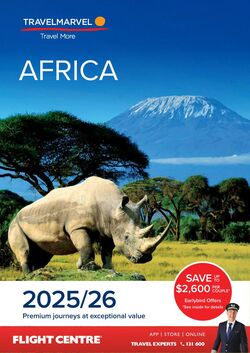
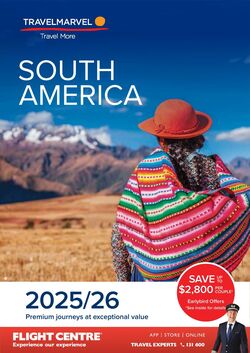
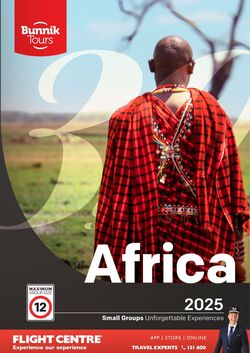
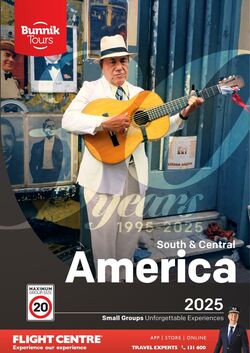

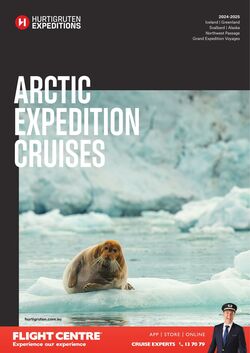
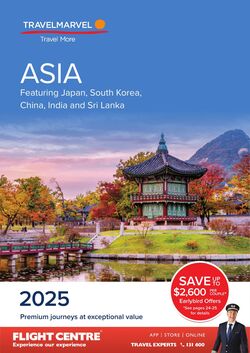
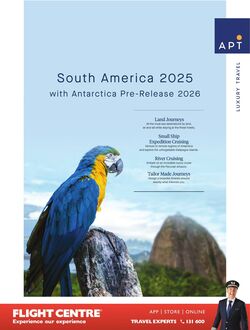
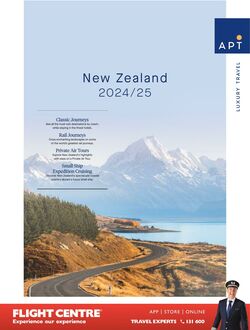
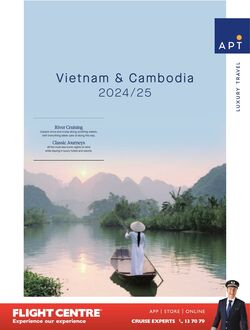
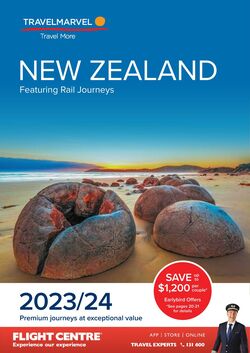
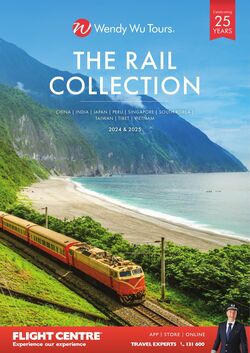
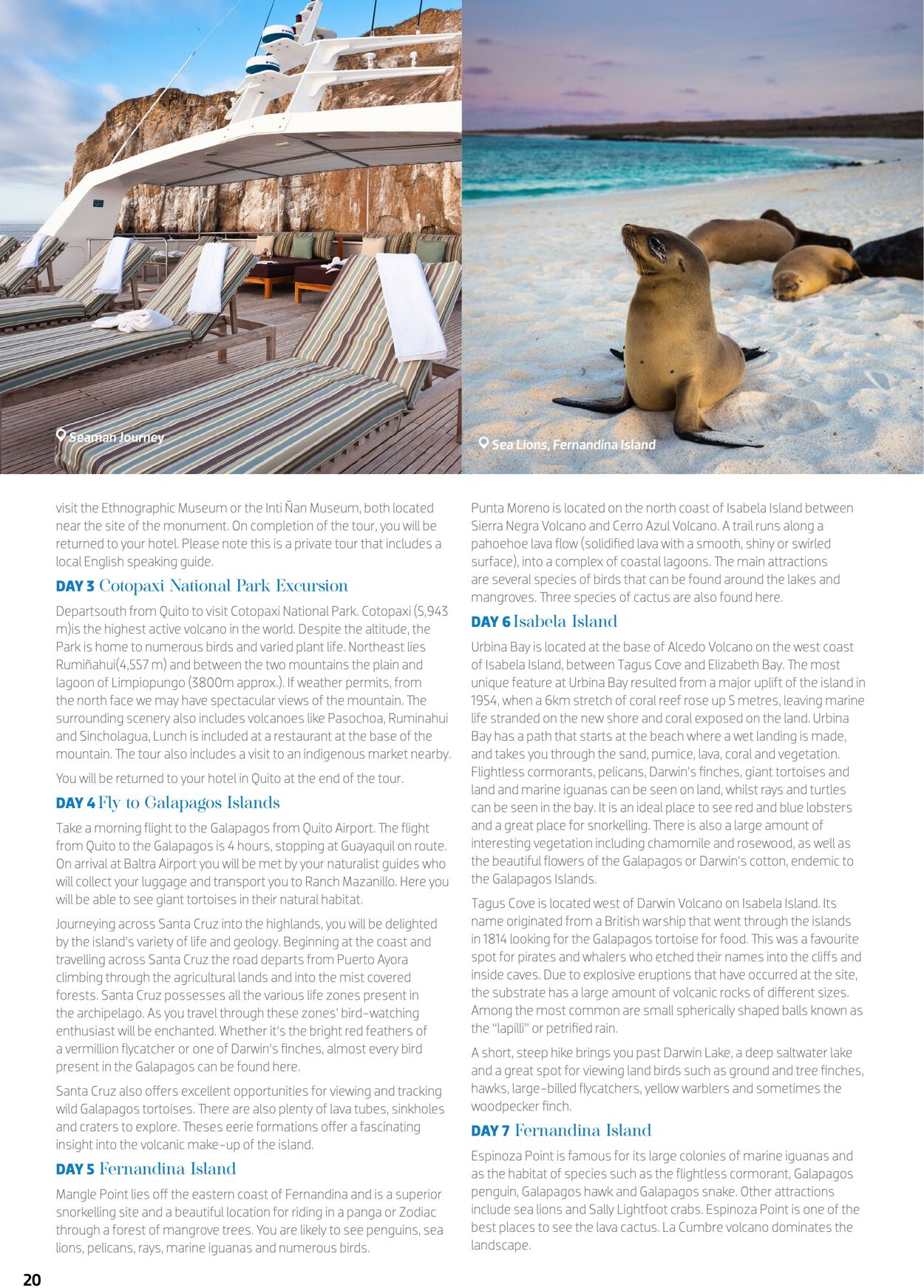
Products in this catalogue
20 visit the Ethnographic Museum or the Inti Nan Museum, both located near the site of the monument. On completion of the tour, you will be returned to your hotel. Please note this is a private tour that includes a local English speaking guide DAY 3 Cotopaxi National Park Excursion Departsouth from Quito to visit Cotopaxi National Park. Cotopaxi (5,943 m)is the highest active volcano in the world. Despite the altitude, the Park is home to numerous birds and varied plant life. Northeast lies Rumifiahui(4,557 m) and between the two mountains the plain and lagoon of Limpiopungo (3800m approx.). If weather permits, from the north face we may have spectacular views of the mountain, The surrounding scenery also includes volcanoes like Pasochoa, Ruminahui and Sincholagua, Lunch is included at a restaurant at the base of the mountain, The tour also includes a visit to an indigenous market nearby. You will be returned to your hotel in Quito at the end of the tour. DAY 4 Fly to Galapagos Islands Take a morning flight to the Galapagos from Quito Airport. The flight from Quito to the Galapagos is 4 hours, stopping at Guayaquil on route. On arrival at Baltra Airport you will be met by your naturalist guides who will collect your luggage and transport you to Ranch Mazanillo, Here you will be able to see giant tortoises in their natural habitat. Journeying across Santa Cruz into the highlands, you will be delighted by the island's variety of life and geology. Beginning at the coast and travelling across Santa Cruz the road departs from Puerto Ayora climbing through the agricultural lands and into the mist covered forests. Santa Cruz possesses all the various life zones present in the archipelago. As you travel through these zones' bird-watching enthusiast will be enchanted, Whether it's the bright red feathers of avermillion flycatcher or one of Darwin's finches, almost every bird present in the Galapagos can be found here. Santa Cruz also offers excellent opportunities for viewing and tracking wild Galapagos tortoises. There are also plenty of lava tubes, sinkholes and craters to explore. Theses eerie formations offer a fascinating insight into the volcanic make-up of the island. DAYS lernandina Island Mangle Point lies off the eastern coast of Fernandina and is a superior snorkelling site and a beautiful location for riding in a panga or Zodiac through a forest of mangrove trees. You are likely to see penguins, sea lions, pelicans, rays, marine iguanas and numerous birds. Punta Moreno is located on the north coast of Isabela Island between Sierra Negra Volcano and Cerro Azul Volcano. A trail runs along a pahoehoe lava flow (solidified lava with a smooth, shiny or swirled surface), into a complex of coastal lagoons. The main attractions are several species of birds that can be found around the lakes and mangroves. Three species of cactus are also found here. DAY 6 Isabela Island Urbina Bay is located at the base of Alcedo Volcano on the west coast of Isabela Island, between Tagus Cove and Elizabeth Bay. The most unique feature at Urbina Bay resulted from a major uplift of the island in 1954, when a 6km stretch of coral reef rose up S metres, leaving marine life stranded on the new shore and coral exposed on the land. Urbina Bay has a path that starts at the beach where a wet landing is made, and takes you through the sand, pumice, lava, coral and vegetation. Flightless cormorants, pelicans, Darwin's finches, giant tortoises and land and marine iguanas can be seen on land, whilst rays and turtles can be seen in the bay. Itis an ideal place to see red and blue lobsters and a great place for snorkelling. There is also a large amount of interesting vegetation including chamomile and rosewood, as well as the beautiful flowers of the Galapagos or Darwin's cotton, endemic to the Galapagos Islands Tagus Cove is located west of Darwin Volcano on Isabela Island. Its name originated from a British warship that went through the islands in 1814 looking for the Galapagos tortoise for food. This was a favourite spot for pirates and whalers who etched their names into the cliffs and inside caves. Due to explosive eruptions that have occurred at the site, the substrate has a large amount of volcanic rocks of different sizes. Among the most common are small spherically shaped balls known as the “lapilli" or petrified rain, Asshort, steep hike brings you past Darwin Lake, a deep saltwater lake and a great spot for viewing land birds such as ground and tree finches, hawks, large-billed flycatchers, yellow warblers and sometimes the woodpecker finch. DAY 7 [Fernandina Island Espinoza Point is famous for its large colonies of marine iguanas and as the habitat of species such as the flightless cormorant, Galapagos penguin, Galapagos hawk and Galapagos snake. Other attractions include sea lions and Sally Lightfoot crabs. Espinoza Point is one of the best places to see the lava cactus. La Cumbre volcano dominates the landscape.
| Name | Details |
|---|